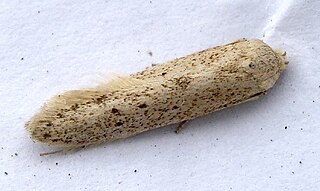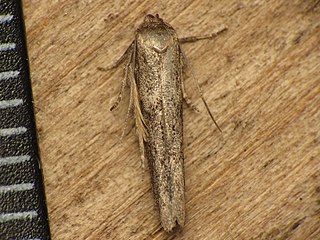
The Blastobasidae are a family of moths in the superfamily Gelechioidea. Its species can be found almost anywhere in the world, though in some places they are not native but introduced by humans. In some arrangements, these moths are included in the case-bearer family (Coleophoridae) as subfamily Blastobasinae. The Symmocidae are sometimes included in the Blastobasidae as subfamily or tribe.

Blastobasis is the type genus of the gelechioid moth family Blastobasidae; in some arrangements these are placed in the case-bearer family (Coleophoridae) as a subfamily. Within the Blastobasidae, the subfamily Blastobasinae has been established to distinguish the Blastobasis lineage from the group around Holcocera, but the delimitation is not yet well-resolved.

Blastobasis adustella is a species of moth of the family Blastobasidae. It is endemic to Australian region, but was introduced in western Europe and is now reported from The Netherlands, Great Britain, Ireland, Madeira and the Azores
Blastobasis anthoptera is a moth of the family Blastobasidae. It is found in Australia and New Guinea.
Blastobasis homadelpha is a moth of the family Blastobasidae. It is found in Australia and Samoa.
Blastobasis monozona is a moth of the family Blastobasidae. It is found in Australia.
Blastobasis nephelias is a moth of the family Blastobasidae. It is found in Australia.
Blastobasis vittata is a moth of the family Blastobasidae. It was thought to be endemic to Madeira but is now known to inhabit the Netherlands, France, the Channel Islands, England and Northern Ireland.

Blastobasis glandulella is a species of moth of the family Blastobasidae. It is found in the eastern United States and southern Ontario, Canada. It has also been recorded in California. In Europe, it has been recorded from Austria, Germany, the Czech Republic, Italy, Slovakia and Croatia.
Blastobasis quaintancella is a moth in the family Blastobasidae. It is found in the eastern United States, including Maine and Florida.
Blastobasis repartella is a moth in the family Blastobasidae. It is found in the United States, including Colorado, Maine, South Dakota and Illinois.

Blastobasis phycidella is a moth in the family Blastobasidae. It is found in most of Europe.

Blastobasis decolorella is a moth in the family Blastobasidae. It is found on Madeira and in Portugal. Records from England and possibly also the Netherlands are based on misidentifications of Blastobasis lacticolella.
Blastobasis desertarum is a moth in the family Blastobasidae. It is found on Madeira and the Azores. The species was recorded from greenhouses in Berlin in 2005, where it was incidentally introduced.
Blastobasis magna is a moth in the family Blastobasidae. It is found on the Channel Islands, in Italy, Portugal, Spain and on Sardinia and Sicily.
Blastobasis maroccanella is a moth in the family Blastobasidae. It is found on the Azores, Madeira and in Portugal, Spain and Morocco. It was recently reported from California in the United States.
Blastobasis confectella is a moth in the family Blastobasidae. It is found in the United States, including Texas.
Blastobasis retectella is a moth in the family Blastobasidae. It is found in the United States, including Texas, Florida and Maine.





